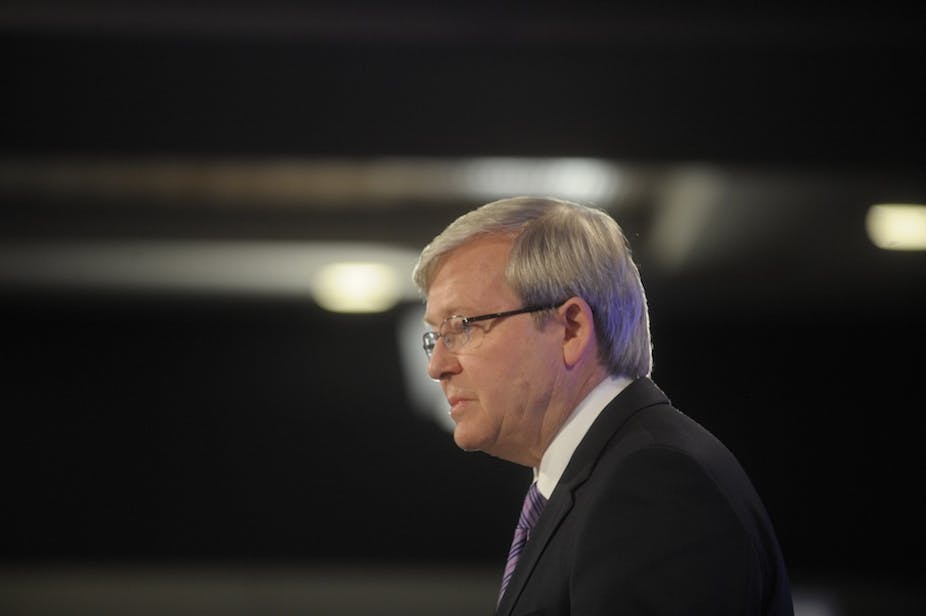Nothing could have signalled more clearly the repositioning of the Australian government’s economic narrative than prime minister Kevin Rudd’s speech to the National Press Club. Nor was this change in the narrative unconnected with the new political game-plan leading up to the federal election in a few weeks or months’ time. The two are closely interdependent.
Essentially the prime minister has conceded what has gradually and in some cases grudgingly become a consensus among economists – that the commodity prices phase of the mining boom is over, and that while investment, output and exports may continue to grow, the returns will be lower. With the trending down of commodity prices, we are also seeing a decline in the terms of trade, which over the last six years provided a 15% boost to our national income.
Where will growth come from to replace the terms of trade boost to our economy? In the 1990s, most of the growth was delivered by Australia’s stellar productivity performance which, to some extent as a result of the reforms of the Hawke-Keating government, exceeded the OECD average over that period. Now our productivity growth, however measured, is lagging the rest of the world, and will not compensate for the terms of trade decline in the absence of new ideas and reform initiatives.
This is the central message of the prime minister’s speech, which argues that “Australia is now an economy in transition”. The transition he has in mind is from “putting all our eggs in just one basket” – the resources and energy sector – to a more diversified economy around manufacturing, food production, infrastructure and services. The problem is that the trade-exposed industries that are being called upon as a source of future growth have also been weakened over the economic cycle by the intensified competitive pressures brought about by the high dollar.
This is a scenario that could - and was - predicted. It is a classic case of the “Dutch disease”, which was experienced as a loss of competitiveness by the Netherlands in the 1970s after the discovery of North Sea gas. The same scenario unfolded in the UK when the windfall gains from its own North Sea oil and gas boom in the 1980s were frittered away in tax cuts, instead of being used to prepare for a future without oil. Only Norway learnt the lessons with a resource rent tax and sovereign wealth fund to simultaneously quarantine adverse exchange rate effects and enable transformative investment in research and innovation.
However, we are where we are, and Rudd has set out an agenda for urgent and collaborative reform based on a step change improvement of Australia’s productivity performance and the need to identify and capitalise on new sources of growth. Importantly, he has recognised that the problem is not simply one of cost competitiveness, though of course business costs such as electricity remain an issue. Australia can only compete as a high cost economy by moving up the value chain through uniqueness, creativity, innovativeness and agility.
This is the significance of Rudd’s emphasis on the role of Australia in the “Asian Century”. We have a remarkable opportunity as a nation to develop our capability and expertise in a range of activities beyond the resources sector in our relationship with the rapidly emerging economies in our region. Former prime minister Julia Gillard may take some of the credit for the adoption of an increasingly “joined up” approach to the innovation, skills and productivity agenda, but there is still much that needs to be done.
In particular, the incoming Minister for Innovation, Industry, Science, Research and Higher Education, Kim Carr has been handed responsibility for some of the major challenges in this area and few would be better equipped to meet them. However, Carr must also be given the fiscal scope to do so as effectively and efficiently as possible in the context not just of a quick fix but a long term strategy for growth and jobs. This must mean reversing the damaging A$3.8 billion cuts to higher education as a high priority for the government.
How can Australia become a competitive knowledge-based economy in our region if we lag behind in this crucial area of investment? This is the non-negotiable entry price for participation in the new global market opportunities and supply chains of the Asian Century. Yet remarkably in Australia public funding per student is back to where it was when the Labor government was first elected, and universities are once again faced with the prospect of cross-subsidising research infrastructure from student fee income.
With comparatively low debt and deficits, highlighted by the prime minister himself, Australia can afford to finance its research and innovation infrastructure needs through increased borrowing at the lowest interest rates in recent economic history. Indeed we cannot afford not to. Along with measures to deepen the engagement of universities with industry and develop the management and innovation capability of our firms, this investment in our future must be at the core of the national productivity agenda.

